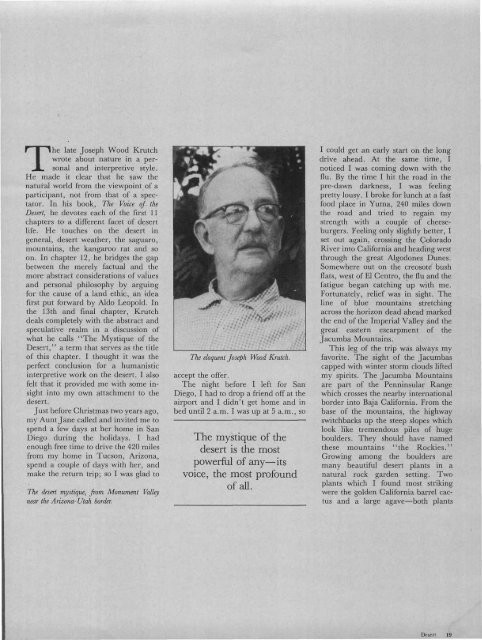December, 1981 $2.00 - Desert Magazine of the Southwest
December, 1981 $2.00 - Desert Magazine of the Southwest
December, 1981 $2.00 - Desert Magazine of the Southwest
You also want an ePaper? Increase the reach of your titles
YUMPU automatically turns print PDFs into web optimized ePapers that Google loves.
The late Joseph Wood Krutch<br />
wrote about nature in a personal<br />
and interpretive style.<br />
He made it clear that he saw <strong>the</strong><br />
natural world from <strong>the</strong> viewpoint <strong>of</strong> a<br />
participant, not from that <strong>of</strong> a spectator.<br />
In his book, The Voice <strong>of</strong> <strong>the</strong><br />
<strong>Desert</strong>, he devotes each <strong>of</strong> <strong>the</strong> first 11<br />
chapters to a different facet <strong>of</strong> desert<br />
life. He touches on <strong>the</strong> desert in<br />
general, desert wea<strong>the</strong>r, <strong>the</strong> saguaro,<br />
mountains, <strong>the</strong> kangaroo rat and so<br />
on. In chapter 12, he bridges <strong>the</strong> gap<br />
between <strong>the</strong> merely factual and <strong>the</strong><br />
more abstract considerations <strong>of</strong> values<br />
and personal philosophy by arguing<br />
for <strong>the</strong> cause <strong>of</strong> a land ethic, an idea<br />
first put forward by Aldo Leopold. In<br />
<strong>the</strong> 13th and final chapter, Krutch<br />
deals completely with <strong>the</strong> abstract and<br />
speculative realm in a discussion <strong>of</strong><br />
what he calls "The Mystique <strong>of</strong> <strong>the</strong><br />
<strong>Desert</strong>," a term that serves as <strong>the</strong> title<br />
<strong>of</strong> this chapter. I thought it was <strong>the</strong><br />
perfect conclusion for a humanistic<br />
interpretive work on <strong>the</strong> desert. I also<br />
felt that it provided me with some insight<br />
into my own attachment to <strong>the</strong><br />
desert.<br />
Just before Christmas two years ago,<br />
my Aunt Jane called and invited me to<br />
spend a few days at her home in San<br />
Diego during <strong>the</strong> holidays. I had<br />
enough free time to drive <strong>the</strong> 420 miles<br />
from my home in Tucson, Arizona,<br />
spend a couple <strong>of</strong> days with her, and<br />
make <strong>the</strong> return trip; so I was glad to<br />
The desert mystique, from Monument Valley<br />
near <strong>the</strong> Arizona- Utah border.<br />
The eloquent Joseph Wood Krutch.<br />
accept <strong>the</strong> <strong>of</strong>fer.<br />
The night before I left for San<br />
Diego, I had to drop a friend <strong>of</strong>f at <strong>the</strong><br />
airport and I didn't get home and in<br />
bed until 2 a.m. I was up at 5 a.m., so<br />
The mystique <strong>of</strong> <strong>the</strong><br />
desert is <strong>the</strong> most<br />
powerful <strong>of</strong> any—its<br />
voice, <strong>the</strong> most pr<strong>of</strong>ound<br />
<strong>of</strong> all.<br />
I could get an early start on <strong>the</strong> long<br />
drive ahead. At <strong>the</strong> same time, I<br />
noticed I was coming down with <strong>the</strong><br />
flu. By <strong>the</strong> time I hit <strong>the</strong> road in <strong>the</strong><br />
pre-dawn darkness, I was feeling<br />
pretty lousy. I broke for lunch at a fast<br />
food place in Yuma, 240 miles down<br />
<strong>the</strong> road and tried to regain my<br />
strength with a couple <strong>of</strong> cheeseburgers.<br />
Feeling only slightly better, I<br />
set out again, crossing <strong>the</strong> Colorado<br />
River into California and heading west<br />
through <strong>the</strong> great Algodones Dunes.<br />
Somewhere out on <strong>the</strong> creosote bush<br />
flats, west <strong>of</strong> El Centro, <strong>the</strong> flu and <strong>the</strong><br />
fatigue began catching up with me.<br />
Fortunately, relief was in sight. The<br />
line <strong>of</strong> blue mountains stretching<br />
across <strong>the</strong> horizon dead ahead marked<br />
<strong>the</strong> end <strong>of</strong> <strong>the</strong> Imperial Valley and <strong>the</strong><br />
great eastern escarpment <strong>of</strong> <strong>the</strong><br />
Jacumba Mountains.<br />
This leg <strong>of</strong> <strong>the</strong> trip was always my<br />
favorite. The sight <strong>of</strong> <strong>the</strong> Jacumbas<br />
capped with winter storm clouds lifted<br />
my spirits. The Jacumba Mountains<br />
are part <strong>of</strong> <strong>the</strong> Penninsular Range<br />
which crosses <strong>the</strong> nearby international<br />
border into Baja California. From <strong>the</strong><br />
base <strong>of</strong> <strong>the</strong> mountains, <strong>the</strong> highway<br />
switchbacks up <strong>the</strong> steep slopes which<br />
look like tremendous piles <strong>of</strong> huge<br />
boulders. They should have named<br />
<strong>the</strong>se mountains "<strong>the</strong> Rockies."<br />
Growing among <strong>the</strong> boulders are<br />
many beautiful desert plants in a<br />
natural rock garden setting. Two<br />
plants which I found most striking<br />
were <strong>the</strong> golden California barrel cactus<br />
and a large agave—both plants<br />
<strong>Desert</strong> 19

















